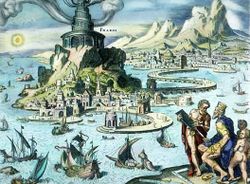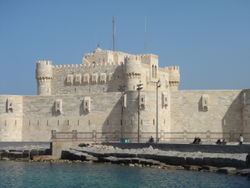Lighthouse of Alexandria
2007 Schools Wikipedia Selection. Related subjects: Ancient History, Classical History and Mythology
The Pharos of Alexandria was a tower built in the 3rd century BC (between 285 and 247 BC) on the island of Pharos in Alexandria, Egypt to serve as that port's landmark, and later, its lighthouse.
With a height variously estimated at between 115 and 135 metres (383 - 440 ft) it was among the tallest man-made structures on Earth for many centuries, and was identified as one of the Seven Wonders of the World by classical writers.
It ceased operating and was largely destroyed as a result of an earthquake in 1375; some of its remains were found on the floor of Alexandria's Eastern Harbour by divers in 1994. More of the remains have subsequently been revealed by satellite imaging .
Constructed from large blocks of light-coloured stone, the tower was made up of three stages: a lower square section with a central core, a middle octagonal section, and, at the top, a circular section. At its apex was positioned a mirror which reflected sunlight during the day; a fire was lit at night. Extant Roman coins struck by the Alexandrian mint show that a statue of a triton was positioned on each of the building's 4 corners. A statue of Poseidon stood atop the tower during the Roman period.
The design of minarets in many early Islamic mosques many centuries later followed a similar three-stage design to that of the Pharos, attesting to the building's broader architectural influence.
Legends tell of the light from the Pharos being used to burn enemy ships before they could reach shore, however this is unlikely due to the relatively poor quality of optics and reflective technology in the period during which the building existed. Only slightly less impressive - and probably more accurate - is the claim that the light from the lighthouse could be seen up to 35 miles (56 km) from shore.
Pharos later became the etymological origin of the word 'lighthouse' in many Romance languages, such as French (phare), Italian (faro), Portuguese (farol), Spanish (faro) and Romanian (far).
History
Pharos was a small island just off the coast of Alexandria. It was linked to the mainland by a man-made connection named the Heptastadion, which thus formed one side of the city's harbour. As the Egyptian coast is very flat and lacking in the kind of landmark used at the time for navigation, a marker of some sort at the mouth of the harbour was deemed necessary - a function the Pharos was initially designed to serve. Use of the building as a lighthouse, with a fire and reflective mirrors at the top, is thought to date to around the 1st Century AD, during the Roman period. Prior to that time the Pharos served solely as a navigational landmark.
The building was designed by Sostratus of Cnidus ( Greek: Σώστρατος Κνίδιος - Sostratos of Knidos or the Cnidian) in the 3rd century BC, after having been initiated by Satrap (governor) Ptolemy I of Egypt, Egypt's first Hellenistic ruler and a general of Alexander the Great. After Alexander died unexpectedly at age 33, Ptolemy Soter (Saviour, named so by the inhabitants of Rhodes) made himself king in 305 BC and ordered the construction of the Pharos shortly thereafter. The building was finished during the reign of his son, Ptolemy II Philadelphos.
According to popular legend, Sostratus was forbidden by Ptolemy from putting his name on his work. But the architect left the following inscription on the base's walls nonetheless: Sostratus, the son of Dexiphanes, the Cnidian, dedicated (or erected) this to the Saviour Gods, on behalf of those who sail the seas (the original Greek inscription
ΣΟΣΤΡΑΤΟΣ ΔΕΞΙΦΑΝΟΥ ΚΝΙΔΙΟΣ ΘΕΟΙΣ ΣΩΤΕΡΣΙΝ ΥΠΕΡ ΤΩΝ ΠΛΩΙΖΟΜΕΝΩΝ
literally means: Sostratos of Dexiphanes [meaning: son of Dexiphanes] the Cnidian to Saviour Gods on behalf of the sea-faring. These words were hidden under a layer of plaster, on top of which was chiselled another inscription honouring Ptolemy the king as builder of the Pharos. After centuries the plaster wore away, revealing the name of Sostratus.
The Pharos' walls were strengthened in order to withstand the pounding of the waves through the use of molten lead to hold its masonry together, and possibly as a result the building survived the longest of the Seven Wonders - with the sole exception of the Great Pyramid of Giza. It was still standing when the Muslim traveller Ibn Jubayr visited the city in 1183. He said of it that: "Description of it falls short, the eyes fail to comprehend it, and words are inadequate, so vast is the spectacle." It appears that in his time there was a mosque located on the top. It was severely damaged by two earthquakes in 1303 and 1323, to the point that the Arab traveller Ibn Battuta reported not being able to enter the ruin. Even the stubby remnant disappeared in 1480, when the then-Sultan of Egypt, Qaitbay, built a medieval fort on the former location of the building, using some of the fallen stone. The remnants of the Pharos that were incorporated into the walls of Fort Qaitbey are clearly visible due to their excessive size in comparison to surrounding masonry.
The Pharos in games
- The Lighthouse is among the World Wonders that can be built in the Civilization computer game series; in the third and fourth installments of the series it is known as the Great Lighthouse along with Empire Earth.
- The Lighthouse is a late-Age structure buildable in Age of Mythology.
- The Lighthouse is one of the World Wonders to be captured in the computer game, Rome Total War, which grants benefits to the owner.
- The Lighthouse is in the Mare Nostrum board game.
- The Lighthouse is one of the wonders of the world in the computer game Empire Earth.


